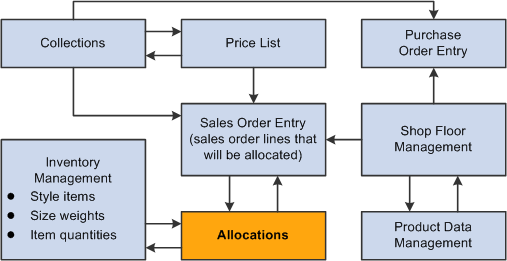Understanding Allocations for JD Edwards EnterpriseOne Apparel Management
The JD Edwards EnterpriseOne Apparel Management system facilitates the wholesale allocation and delivery of style items.
You use allocation rules to facilitate the effective and efficient distribution of available style items to fill sales orders. You define allocation rules based on your business requirements.
Sales orders may contain a large number of detail order lines for style items that have a short period of time for initial delivery. One sales order line consists of a group of child style items.
Work order receipts for discrete item manufacturing are often spread among many sizes of child style items. You use allocation rules to determine which customer gets what items and in what sizes. If one size cannot be shipped, then you create exceptions or overrides in the allocation rules to determine when not to ship items and when to deliver. All allocation rules are applicable to sales orders for style items only.
Allocation rules enable:
-
Dynamic order priority definition.
The system prioritizes the sales orders.
-
Delivery of meaningful orders.
You can use allocation rules to define what style items can and cannot ship together.
-
Coordinating style items.
For example, coordinates such as jackets and trousers are delivered at the same time. Other coordinates can be sold separately too. You use top and bottom management functionality to coordinate style items that you deliver at the same time.
-
Size proportionality.
Distributing available goods to sales orders proportionately is more reasonable than delivering all available goods to a single order.
-
Size weight.
The frequently used sizes in the market are set with a higher weightage than the sizes which are rarely used or used by the minority of people.
For example, the most common required sizes, such as medium (M) and large (L), need to be delivered more frequently compared to sizes such as extra small (XS) and extra large (XL).
-
-
Automatic shortage management.
When available quantity is less than the total demand from sales orders, you can use allocations to balance the delivery of goods to the sales orders by allocating a certain percentage of the demand. You use the sprinkling rate or fair share processing in allocations to automatically manage shortages.
-
Seasonal order availability.
For seasonal orders, availability is zero during sales order entry. For nonstyle items the standard JD Edwards EnterpriseOne business process is to backorder items with no availability. However, this may not be a desirable practice for style items in some industries.
-
Proposals with manual or automatic validation.
You can validate proposals manually or use an automatic process.
Allocations are performed by the system based on the allocation rules defined by the user. You can also use allocation rules to create buffer stock to keep building inventory to fill large, high-priority sales orders.
You can generate allocation and delivery proposals for style items. Allocation proposals enable you to share the available stock among several sales orders in the case of product shortages. Delivery proposals ensure that the appropriate number of goods are shipped as needed.
You can manage the allocation and delivery proposal processes at the same time if you set constraints at the same time that you allocate stock. The processes can also be split and run separately. In this case, you first allocate the stock (hard commitment) and then manage delivery constraints.
This diagram illustrates the integration between the allocations process and other JD Edwards EnterpriseOne programs and systems:

The calculation of allocations for style items uses one of the following processes:
-
Manual allocations
-
Automatic allocations
The Automatic Allocations process may consist of calculating both allocation and delivery proposals.